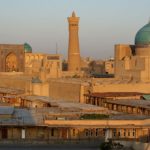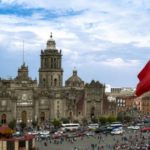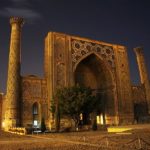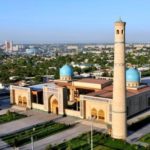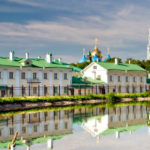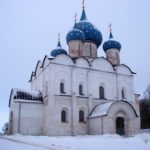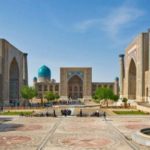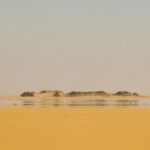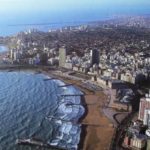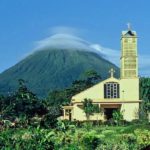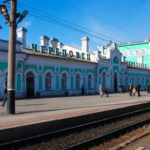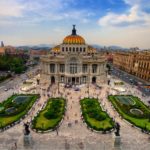On the way to Bukhara
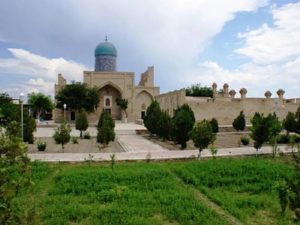 On the way between Samarkand and Bukhara, literally in the middle of the desert, you suddenly see the silhouettes of a large, modern city in front of your eyes. This Navoi is one of the youngest cities of Uzbekistan. High-rise buildings, fountains, factory buildings and factories appear like a fairy-tale mirage in the sands. And here live metallurgists, chemists, gold miners.
On the way between Samarkand and Bukhara, literally in the middle of the desert, you suddenly see the silhouettes of a large, modern city in front of your eyes. This Navoi is one of the youngest cities of Uzbekistan. High-rise buildings, fountains, factory buildings and factories appear like a fairy-tale mirage in the sands. And here live metallurgists, chemists, gold miners.
Near Navoi, along the modern road “Shokh Rokh”, is located the old city of Karman. In ancient times it was the fortified city of Sogdians on the border of the Bukhara agricultural oasis. The city was located on the ancient caravan route, by the river, in the part of Prizeravshaniya inhabited and the richest in natural resources. In the middle of the city at one time was a citadel.
Karmana occupied a favorable position on the ancient trade route between Bukhara and Samarkand, being at the crossroads of caravan routes. Medieval authors called Karman “prosperous”, “blessed”.
During the reign of Bukhara Emir Abdulahad Khan in Karman, in the place Charmgarchorbog, was the residence of the Bukhara emir. The well-groomed gardens of Charmgarchorbog and Gulchorbog were famous at that time for their rich collections of various varieties of roses and grapes. At the direction of the emir, foreign ornamental trees and shrubs were brought here. Emir Abdulahad-Khan, a native of these places, moved from Bukhara to Karmana in 1 894 and lived here until his death in 1 910. Here, at the Kasim Sheikh Cathedral Mosque, the emir was buried.
Between Karmana and Navoi, on the right side of the road, you will see the Cathedral Mosque Hanaka Kasym Sheikh, built between 1558-1559. In ancient times, this mosque was a haven for Sufis, dervishes and hermits. The mosque was built here in the XVI century under the ruler of Bukhara Abdulahad Khan. The original and monumental mosque embodied the basic principles of medieval religious architecture and the best achievements of local architects. The tower with a dome of the Kasim Sheikh mosque at one time was the highest in this part of the Zeravshan valley.
In the courtyard of the mosque you will see domed hujras, in which dervishes, wandering pilgrims and pilgrims found refuge for themselves. There is also an impressive crypt with a rich marble lining, decorated with artistic carvings. This is a place of calm for the Kosim Sheikh himself – the leader of dervishes and Sufis.
In the center of the Pockets is another ancient monument – the Mausoleum of Mir-Side Bakhrom, built in the X century. This mausoleum – a brilliant example of the Avicenna era, in many respects resembles the famous Bukhara mausoleum of Ismail Samani. It is built of baked brick in the classical style of the Samanid era, with a charming decorative openwork pattern.
The caravan route connecting Samarkand and Bukhara for millennia, in these places, passed through the hot Malik-Chul steppe, with rare shelters of caravanserais and special dome facilities for storing sardoba water. He revived only at the very Pockets, the crossroads of caravan routes. Further from here, caravans followed to Bukhara, Nurata, Karshi, Samarkand.
From Pockets, drive to the main road and head towards the west. After some time, in front, right by the road, ruins will appear, buildings made of baked brick. Here are the ruins of the medieval caravanserai Rabbati Malik – hotels for visiting merchants. This is one more confirmation of the ancient caravan route. Modern high-speed road to Bukhara through the centuries again passes through the old caravan routes, through the same sites and wells used by the travelers of the Middle Ages.
Stop here, open in your imagination the gates of the caravanserai of the XI century … In antiquity Rabbati Malik served as the main parking for caravans going from Samarkand to Bukhara. Its relatively well-preserved beautiful entrance portal is popularly called the “Golden Gate of Malik-Chulya”.
At the caravanserai, on the left of the road, there is an unusual hydrotechnical structure of antiquity – Sardoba. This domed giant underground storage and storage of water in the XIV-XVI centuries served as a huge peculiar refrigerator in the middle of the steppe. Here, caravans gathered water in front of a long road along the camel trails of Malik-Chulya.
Within the Zerav-Shansky valley, ancient settlements are often found with swollen mounds of citadels, ruins of towers, walls, traces of streets, buildings, defensive moats. Between the village of Khazar of Navoi district and Kyzyltepa, along the high steep steppe bank of the river Zeravshan, you can see the remains of the Great Bukhara Wall – “Kampir devori”. In the old days, this wall encircled the entire Bukhara agricultural oasis and, until the tenth century, defended it from the raids of steppe nomads.
Continuing your journey already on the territory of the Bukhara region, do not forget to stop in Gijduvan. It does not take you much time. Here, in Gijduvan, one of the three madrasas built by the ruler Ulugbek in the 15th century is located. Following in the direction of Bukhara, soon your car will drive to Babkent. From a distance you will see a high minaret towering over the city.
